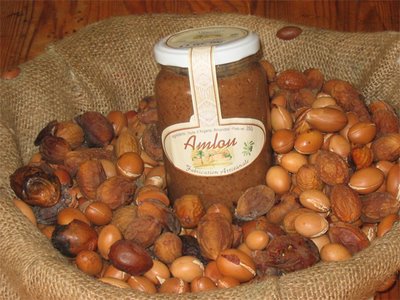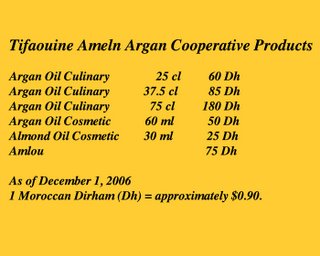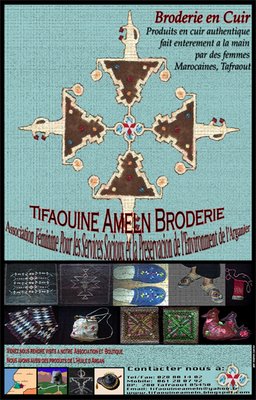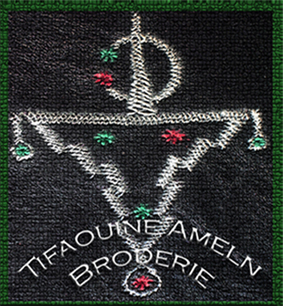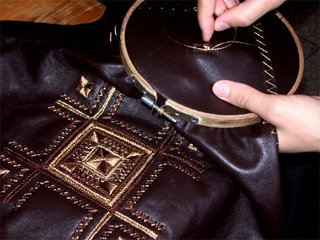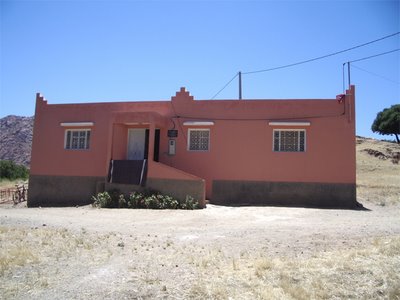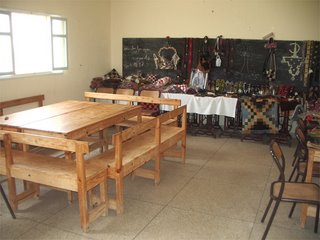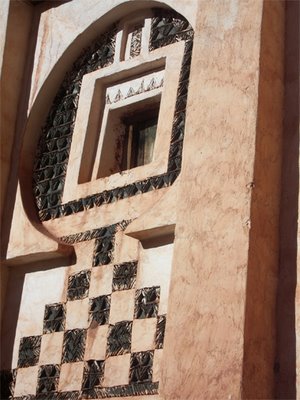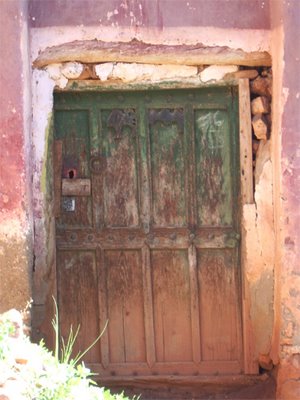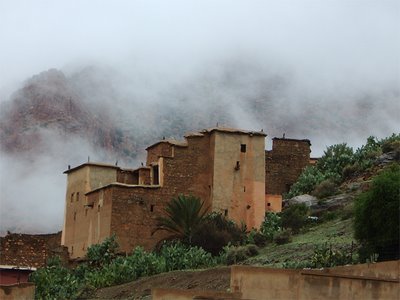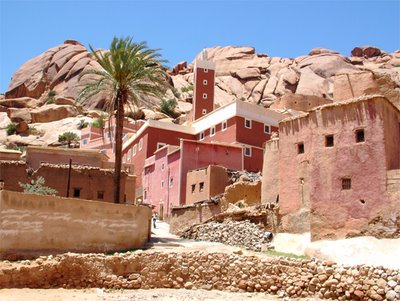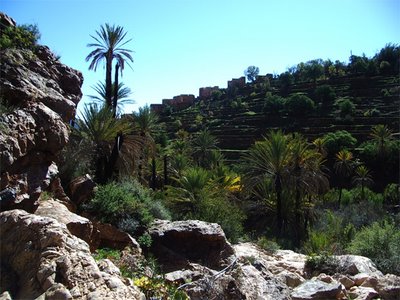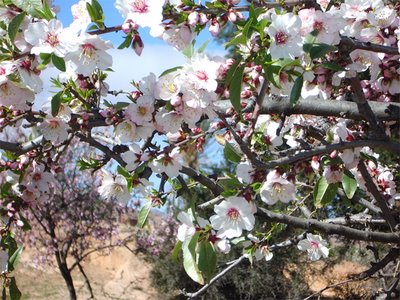
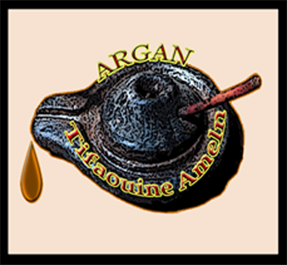
Tifaouine Ameln is a cooperative of rural Moroccan women who specialize in making Argan oil. These 36 women come from various neighboring villages in the enchanting Ameln Valley. They harvest the nuts from the Argan tree during the month of August and then systematically, but not painlessly, turn it into highly sought after edible and cosmetic Argan oil.
Ameln Valley is a large, but rather unpopulated valley among pink and gold craggy granite rocks of the Anti-Atlas and with the formidable ridge of Jebel al-Kest and the lion’s head backing the valley along the north side. There are about 30 only partly inhabited villages (population total in valley around 1,500) against the north mountain range strung together by irrigation canals and goat tracks. The majority of the valley is a lush orchard with olive, dates, almonds, carob, pomegranete, apricot, argan, and barely grown. Families own the trees in the valley. There is a sizable wild pig population – they say there are more wild pig than humans in the valley and they tend to destroy the neat canal tracks and dig up and devour the vegetables grown. Water seems to be plentiful here in the valley as there are many natural springs in the Anti-Atlas. There is a spring that comes down from Tagudicht and winds its way down through Tamalookt and is collected in a pool in Asguine. From there the water is diverted and piped to the houses. Tamaloukt is famous for the quality of its spring water.

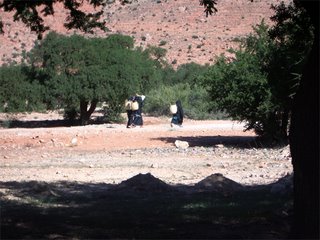
The Ameln Valley is famous for its industrious women and the emigration of men to bigger cities or abroad for work.
There are three Argan cooperatives in the valley and just about every woman makes her own Argan. Argan is extremely important both culturally and environmentally. It is a UNESCO protected tree and not only helps to keep the Sahara Desert at bay, but also is the main source of income for the women in the region. Statistics from the Fair Trade Federation show that worldwide; 70% of the 1.3 billion people surviving on less than $1 a day are women; women are paid 30-40% less than men for comparable work; two-thirds of the world's one billion illiterate adults are women; women in developing countries work an average of 60 to 90 hours a week (much of this work is unpaid and in the home - childcare, cleaning, cooking, and agricultural labour); and young girls account for two-thirds of the 130 million children absent from schools worldwide.
Cooperatives are established in order to reduce feminized poverty, educate women and help them build more capacity for business. Cooperatives also have quality standards for production. Despite the fact that Berbers use Argan oil daily in cooking or for dipping with bread, it has become a high end luxury good in Europe, etc.
The women of the Cooperative's biggest challenge is in securing a constant and stable local and International market. Despite the fact that the local market is over-saturated and it is difficult to compete against the other oil sold in the Tafraout souq that is cheaper (probably because it is mixed with vegetable oil), tourists continue to come to the region specifically to buy argan. Nonetheles, Cooperative Tifaouine Ameln is off the beaten path - that is why in order to be sustainable and truly have a positive impact on reducing feminized poverty and creating fair wages - it is imperative that we diversify our market.
What is Argan Oil?
In addition to being used as a tradition medicine, argan oil is a staple in the Berber diet, usually eaten on bread or in amlou, a sweet oil and almond paste - like peanut butter. The local population obtains as much as 25% of their daily lipid intake from the argan tree.
The tree produces an oval-shaped green fruit which contains 1 -2 kernels inside a pit. In order to extract the kernels from the almond, the almond must first be cracked open. This is the most difficult part of the process. Once these are pounded open, however, the kernels inside are roasted lightly to bring out the flavor. The oil is then ground out. Mixing the resulting paste with warm water brings the oil to the surface where it is then collected for filtering. The waste is fed to the animals.
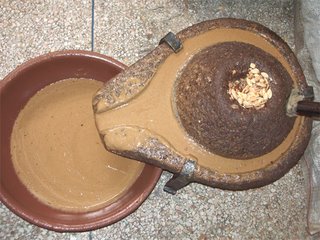

It takes 15-20 hours to produce the 5 1/2 lbs. (2 1/2 kilos) of kernels it is needed to produce one liter of argan oil!
Argan oil’s healthful properties and myriad of uses have helped popularize it. It contains many antioxidants and is rich in vitamin E. These properties alone make argan oil an ideal ingredient for a variety of skin creams and other cosmetic products. It is even used to treat such ailments as arthritis and several companies in Europe have begun using it in the production of vitamin gel tablets. Most importantly, however, the rich aroma and nutty flavor of argan oil make it an exotic ingredient in gourmet kitchens. Though the Berber people of southwestern Morocco have used it for centuries in their cuisine and for medicinal and cosmetic purposes, it has only been within the last decade that argan oil has become known to the outside world.
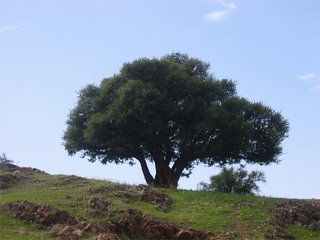
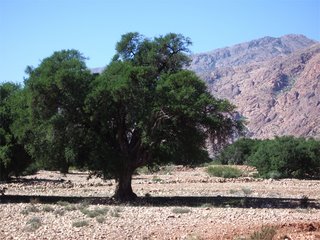
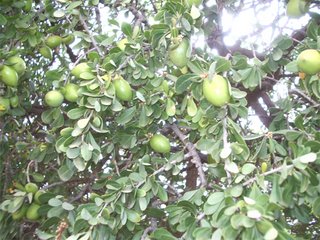




COOPERATIVE PRODUCTS



